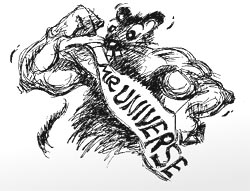Supermouse
 the discovery of a new gene, has led scientists to create a portly breed of mice, with muscles two to three times bigger than those of normal mice. The discovery is of significance as it could help scientists to find treatments for muscular dystrophy or for the gradual muscle wasting that accompanies cancer or aids.
the discovery of a new gene, has led scientists to create a portly breed of mice, with muscles two to three times bigger than those of normal mice. The discovery is of significance as it could help scientists to find treatments for muscular dystrophy or for the gradual muscle wasting that accompanies cancer or aids.
As for immediate benefits, it could boost growth in domestic animals and double the amount of meat content. And the plus point is that in the mice with more muscles, the fat content is similar to that in normal mice. Therefore, farm animals could offer larger yet leaner cuts than those available now. Discovered by a team led by Se-Jin Lee of Johns Hopkins University, us, the gene "has opened up completely new ideas about the control and regulation of muscle growth," Said Brigid Hogan, a professor of cell biology At Vanderbilt University, us.
Lee and his team found the gene in 1992 but did not know of its importance then. While experimenting, they developed a strain of mice in which the newly found gene was 'knocked out' or deleted. The first knockouts were born last year and by about six weeks of age, these mice developed an odd body shape, with unusually big shoulders and hips. It turned out that this was due to muscle; the skeletal muscles were two to three times the size of those in normal mice. No other types of muscle, like cardiac or smooth muscle of the intestines were affected. Most of the bulk was concentrated in the shoulders, face, legs, chest and abdomen. The extra mass is due to an increase in both the number and size of muscle fibres within each muscle.
"We thought maybe the mice wouldn't have any muscle at all," said Alexandra McPherron, part of the research team. "We certainly didn't expect they would have more muscle," she added. The gene belongs to the newest known member of a family of genes, now numbering 30, that regulate cell growth and organ development and is identified as; growth' differentiation factor 8 or myostantin after the protein that it produces. According to Lee, the most immediate findings might be to agriculture. Chickens, cows and pigs all have the gene and if it works in them as it does in mice, knockouts might produce twice as much meat with no more fat.
Scientists are perturbed that removing the myostanin gene might cause cancer. "Other genes in its family are Tumour suppressors and when they are removed or blocked, the animals die of cancer. The new mice are being watched for this," said Lee. So far, no such tumours have been found. The mice, except for their big muscles, appear normal. According to McPherron, the mice are more gentler than normal mice and their movement a wee bit sluggish. They have also proved fertile in matings with their own muscular breed (producing muscular offspring) and with normal mice.
It is yet to be proved if muscular mice are also stronger than normal mice. Those tests are now underway. It also has to be observed whether myostanin would have to be missing from conception for a person to develop larger muscles, or whether a drug that block's myostanin's action in adults might release a new round of muscle growth in bodybuilders or people with muscle diseases.
In animal husbandry, however, it should not be hard to establish this process effectively. "In agriculture, the idea would be to try to delete this gene from chickens, cows, pigs or whatever," said Lee.
Other researchers have welcomed the discovery. Said Joan Massague, a researcher at Memorial Sloan-Kettering Cancer Center in New York, who in the '80s had worked on the family of compounds to which myostanin belongs, "It is very interesting and very exciting and indeed the projected possibilities are sound. The question I would have about this new member of the family is whether, when used as a drug, it will concentrate in the muscle and only in the muscle, or whether, once presented, it would act on other cells too, which might not be desirable."
